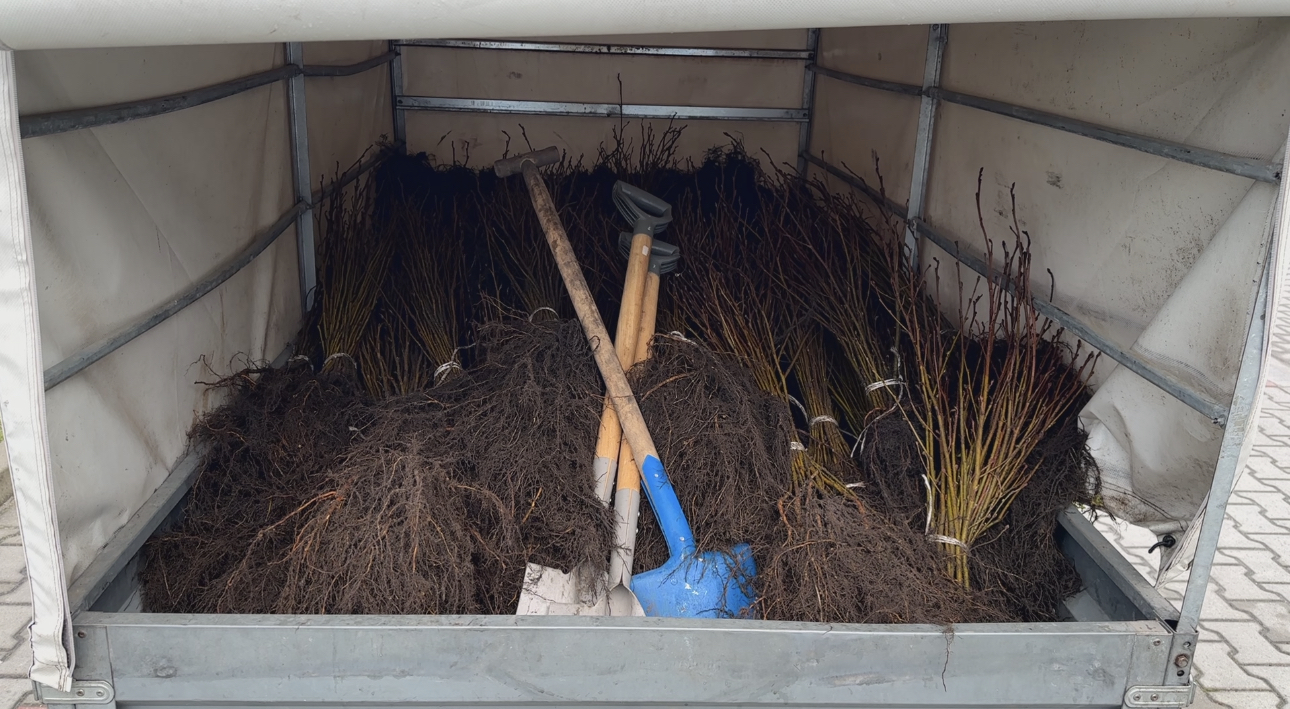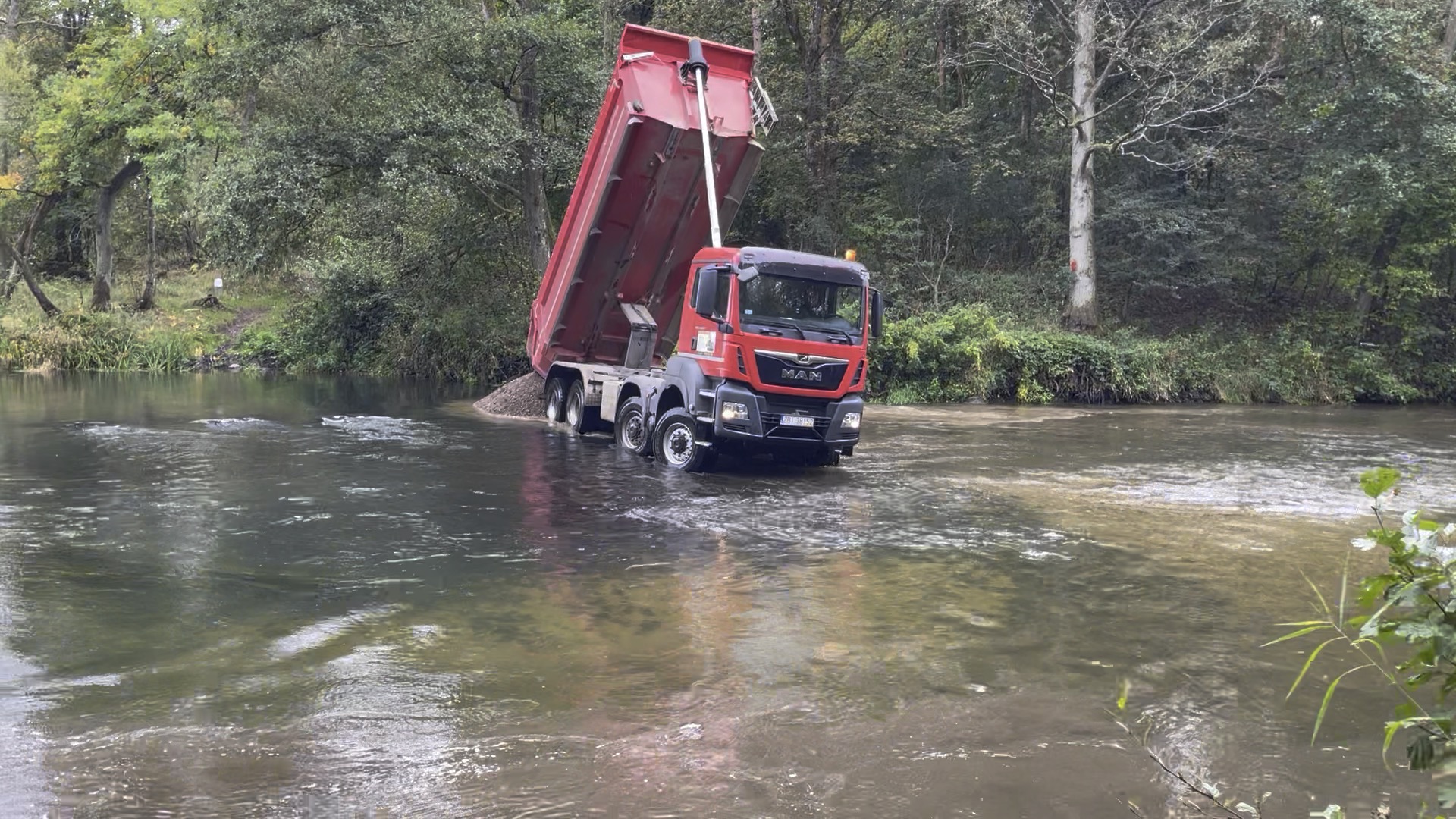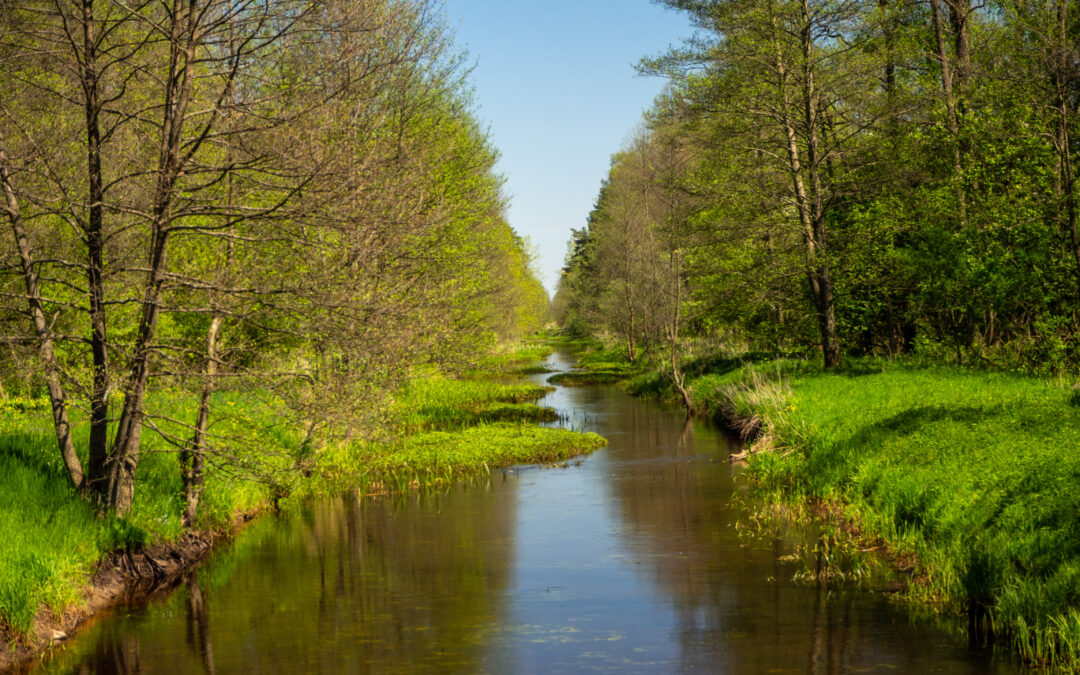By Wojciech Kość
In Poland, both the changing climate and artificially straightened waterways have created conditions that exacerbate flooding. Grassroots initiatives across the country are seeking to restore rivers closer to their natural state, with the aim of mitigating floods, boosting water retention and sustaining biodiversity.
“You handle this. Stick in no more than two or three at a time,” I am instructed as I stand on the bank of the Nida River in southeast Poland on a windy April morning. I am handed a shovel and a bundle of twigs. Dozens more wait in a trailer parked nearby.
The plan: walk along the river and plant very young twigs of the common alder every few metres so that, years and decades from now, they will have grown to provide parts of the river’s course with shade.
“It’s about giving the river different temperature zones. In this way, more species can live in the river, not just those that can handle heat,” says Michał Bień, an ecohydrologist and ichthyologist, and office manager of the Polish Angling Association in Kielce.

Common alder twigs, used in the Nida River tree-planting project (photo credit: Wojciech Kość).
In 2023, Bień headed a tree-planting effort which took place in various locations along the Nida, a river partially degraded in the 1970s by measures to straighten its path and remove trees.
As part of his efforts to reverse the effects of these attempts to regulate the river’s flow, the scientist has this year also been planting trees along four more small rivers in southeastern and eastern Poland. “It’s more than 26,000 trees along over 70 kilometres of rivers in the province around Kielce alone,” Bień says.
Regulation of rivers often entails the artificial straightening of their course – known as channelisation – in order to create a faster flow. This technique has been used since the 19th century, usually with the aim of improving navigability and protecting against flooding.
In fact, with regard to the latter aim, channelisation is now known to be less effective than the natural alternative: meandering rivers with wide floodplains are capable of taking in more water in the event of a flood, while also offering the advantage of retaining water and thus protecting against drought.
Southern Poland has been hit by major flooding, which has so far claimed one life.
The prime minister, on a visit to the worst-affected area, appealed to residents to obey evacuation orders https://t.co/bsdRiVfo59
— Notes from Poland 🇵🇱 (@notesfrompoland) September 15, 2024
Moreover, straightened, faster-flowing rivers lead to less habitable conditions for wildlife, while making it more difficult for plants to establish their roots, which results in reduced biodiversity.
A growing number of individuals and organisations in Poland are now taking care of the country’s rivers, seeing the restoration of their natural qualities as an important method that helps sustain biodiversity and adapt to climate change and the extreme weather it can bring.
“The number of these initiatives has been on the increase in recent years, following the rise in awareness of what it takes to make rivers, their valleys and their drainage basins healthier,” says Ilona Biedroń, who heads the Healthy River Foundation and works at the Institute of Meteorology and Water Management as Poland’s first state expert on surface water restoration.
Restoring rivers is an effective way to boost water retention and thus ensure that there is enough clean water to use in households or by farmers. This is particularly pertinent to Poland, which ranked 24th in the latest Eurostat report on freshwater resources in the EU.
The water level in the Vistula, Poland’s longest river, has fallen to a record low of 25 cm in Warsaw amid an ongoing heatwave.
The level is forecast to drop further in the coming days amid continued warm, dry weather around the country https://t.co/WY0h4ApJAo
— Notes from Poland 🇵🇱 (@notesfrompoland) September 8, 2024
Indeed, rivers are one of the most degraded habitats in Poland. The 2023 review of the state of the country’s environment by state statistical agency GUS assessed the condition of just under 5% of Polish rivers as “good” or “very good”, and “moderate” in 58% of cases.
Meanwhile, 38% were classified as “poor” or “bad”, meaning that their water can be unsafe for farming, municipal use, maintaining biodiversity, and recreational purposes, such as bathing or fishing.
That is largely the results of pollution from agriculture – mainly by the phosphates and nitrates used as fertilisers – but also to the dumping each year of millions of cubic metres of saline water from mining.
High salinity was the underlying cause of a major environmental disaster in 2022 along the Oder, Poland’s second-biggest river, that killed much of its fish and other aquatic life. This year, it once again led to a mass die-off in a canal and lake connected to the Oder.
Sorry to interrupt your reading. The article continues below.

Notes from Poland is run by a small editorial team and published by an independent, non-profit foundation that is funded through donations from our readers. We cannot do what we do without your support.
Environmentalists have long said that the best recipe to lift Poland’s rivers out of their sorry state is to restore degraded rivers back, or close to, their natural state, and make sure no degradation occurs along those rivers that have retained their meandering course.
“If you want to make a river cleaner, make it more natural, because natural cleaning processes – carried out by plant life – are much more efficient,” says Sebastian Szklarek, an ecohydrologist working at the European Regional Centre for Ecohydrology of the Polish Academy of Sciences.
Szklarek says that a river’s health is not solely about water flowing in the riverbed. “A natural river is the riverbed plus the entire valley that it can flood, which reduces the risk of flooding where we wouldn’t like it to happen.”
“A river running straight like a canal isn’t much of a river,” the scientist continues. “It doesn’t have nearly the same number of different habitats along its course that would allow plants and bacteria to thrive and thus keep the water clean.”
Sometimes, it even makes sense to transform a canal into something more river-like to benefit the surrounding habitats. An effort spearheaded by the Regional Environmental Center (REC), an NGO, is about to carry out work along the Łasica, a canal dug through the Kampinos National Park, a large swathe of forest located in the former proglacial valley of the Vistula, Poland’s longest and largest river.
“We’re going to build a number of rapids along the Łasica to reduce the amount of water flushing down the canal, which is currently draining it away from the national park,” says Michał Miazga, the director of the REC, about the project, which has received funding from both the EU and the Polish state.
Since early August, over 100 tonnes of dead fish have been removed from a lake and canal in Poland.
PiS, which was in power during the height of a similar crisis in 2022, accuses the government of hypocrisy and downplaying the disasterhttps://t.co/uQVefxHuVT
— Notes from Poland 🇵🇱 (@notesfrompoland) August 19, 2024
Rapids – which are built by positioning gravel on the riverbed – also help create diverse habitats within a river ecosystem. The variety of flow speeds and depths can support different species of fish, invertebrates and plants, contributing to biodiversity.
“We’re also going to make small ‘interventions’ in the canal’s course to make it meander a little, as that will change the features of the bed, with some sections shallower than others – creating more habitats again,” Miazga adds.
For the uninitiated, such interventions can seem anything but pro-environment, given that they appear to involve humans interfering with nature. For example, a 2022 project by the Polish branch of the World Wide Fund for Nature (WWF) and a local fishing association aimed to build spawning grounds for sea trout along the Parsęta River in northwestern Poland.
A sea trout spawning ground is simply a gravelly section of a riverbed where trout find favourable conditions for the development of their eggs. The project sought to improve biodiversity in the river and make it more attractive for angling.
Building the spawning grounds, however, involved two large trucks driving into the river to offload several tonnes of gravel that was later distributed along a section of the river bed by a tractor. While it didn’t look pretty, its impact on the environment was negligible and sea trout were there laying eggs in the next spawning season.
Such interventions would, of course, not be necessary had the waterways not been regulated and thus degraded decades earlier. In this respect, they are returning rivers to a natural state, rather than interfering with them.

A truck offloads gravel to help create sea trout spawning grounds in the Parsęta River (photo credit: Wojciech Kość)
According to the WWF’s River Guardians project, Poland is home to some 150,000 kilometres of rivers and streams, with up to a quarter of them not or hardly impacted by human activity.
“Compared to Western Europe, we still have a lot worth protecting,” says Szklarek, pointing to long sections of the Vistula, Oder and plenty of other rivers that still flow naturally or whose regulation can be reversed.
“You don’t even have to carry out big works. It’s often enough that you move the levees further from the river and just wait. It will change its course to a more natural meandering one over time,” he adds.
There are around 1,400 sewage outlets on Polish rivers without a valid permit, says the head of the state water agency.
One fifth of these are on the Oder river, where over 100 tonnes of dead fish have washed up amid an ongoing environmental crisis https://t.co/hDeHndy6NC
— Notes from Poland 🇵🇱 (@notesfrompoland) August 24, 2022
Recent years have also seen the authorities start to take tentative steps towards action. A 2020 strategy document by Polish Waters – the state agency tasked with managing Poland’s inland waters – set renaturalisation goals, primarily for rivers and lakes.
Building on the experiences of grassroots projects by NGOs and institutions such as national parks, the document is expected to guide the speeding up of work to improve Polish rivers countrywide by 2027. Currently, over 500 locations have been recommended for carrying out comprehensive analyses in terms of defining specific renaturalisation actions and implementing them.
Sections of some of the most valuable Polish rivers are protected by national parks, such as those in the Narew National Park and the Biebrza National Park, famed across Europe as diverse bird habitats. The Polish government is currently taking steps to create the first national park in Poland since 2000, which will cover the downstream of the Oder River, adjacent to the existing park on the German side of the border.
But it’s the protection of countless smaller streams and rivers that will make a real difference, the likes of which continue to be addressed by grassroots projects across the country.
Main image credit: Robert Drózd/Wikimedia Commons (under CC BY-SA 4.0)




















